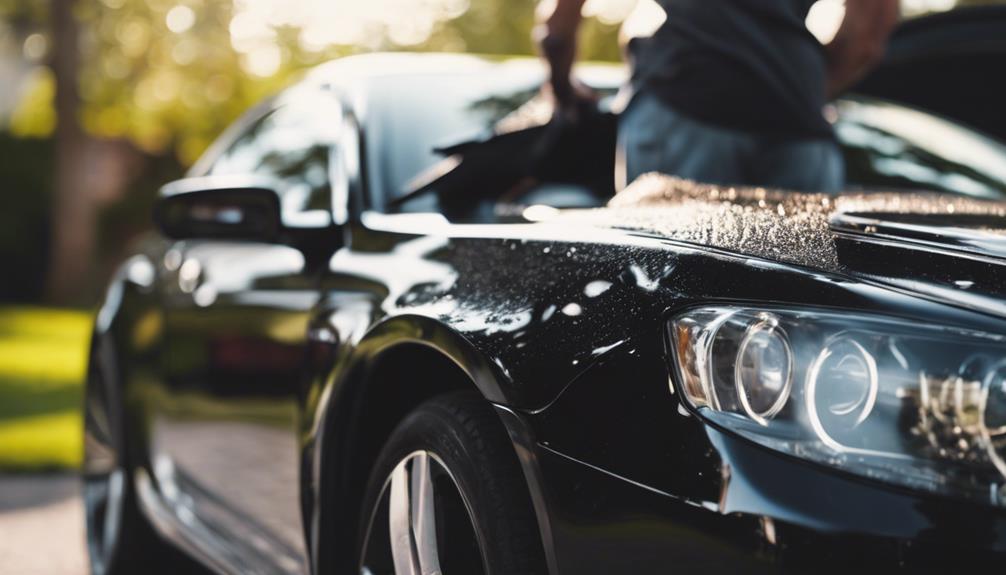How to Maintain Your Car's Shine
- Regular Washing
- Use warm water and car-specific soap.
- Avoid harsh household detergents.
- Proper Drying
- Dry with a microfiber towel or drying chamois.
- Start from the top, working down to avoid streaks.
- Quality Waxing
- Choose natural or synthetic wax based on your needs.
- Buff for a brilliant shine.
- Paint Sealants
- Apply for long-term protection against UV rays and contaminants.
- Detailing Clay
- Use clay to remove embedded contaminants and smooth the surface.
Regular maintenance and the right products make a noticeable difference. There's more to learn about keeping your car pristine.
Regular Washing
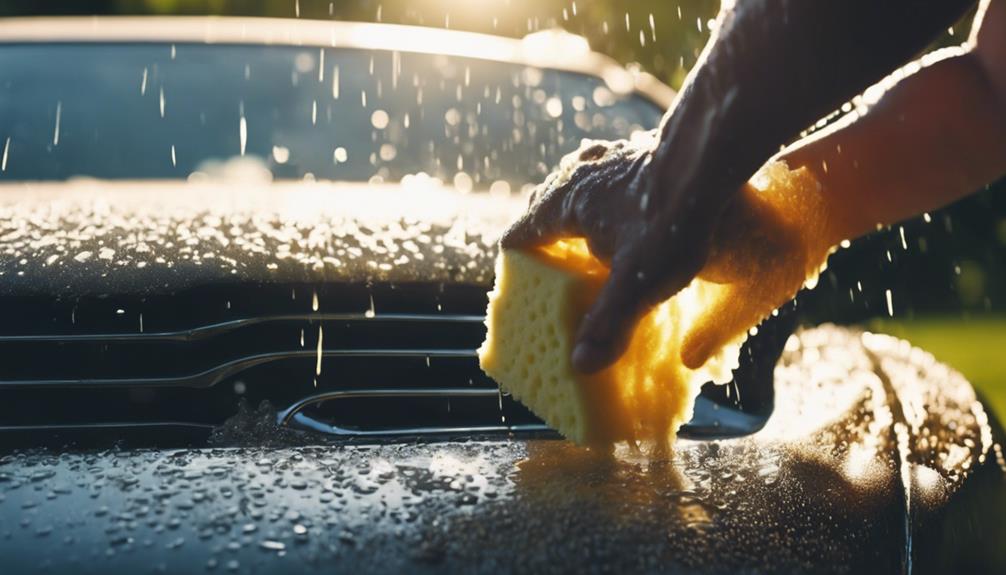
To keep your car looking its best, make sure you wash it regularly. Regular washing helps remove dirt, grime, and contaminants that can damage your car's paint and finish over time.
Water Temperature
- Cold Water: While it's tempting to use cold water because it's readily available, it might not effectively remove all the grime and dirt on your vehicle. Cold water can often cause soap to lather less, reducing its cleaning capability.
- Warm Water: Using warm water is more effective. Warm water helps loosen dirt and grime, making it easier to wash away. However, avoid using hot water as it can damage your car's paint.
Soap Selection
- Car-Specific Soaps: Always use a soap formulated specifically for cars. These soaps are designed to be gentle on your car's paint while effectively removing dirt and grime.
- Household Detergents: Avoid household detergents like dish soap. These can strip away the protective wax and damage your car's finish over time.
Proper Drying
Proper Drying
After thoroughly washing your car, it's important to dry it properly to prevent water spots and streaks. Simply allowing your car to air dry can leave unsightly marks and diminish the shine you've worked hard to achieve. Instead, you should use a drying chamois or a microfiber towel for the best results.
Steps to Properly Dry Your Car:
- Use a Drying Chamois: A drying chamois is highly absorbent and can quickly remove water without scratching the surface. Begin by draping the chamois over large panels, such as the hood and roof, then gently pull it across the surface. Wring out the chamois regularly to maintain its effectiveness.
- Drying Technique: Start from the top of the car and work your way down. This approach guarantees that water doesn't drip onto areas you've already dried. Pay special attention to areas around mirrors, door handles, and trim, where water can accumulate.
- Microfiber Towels: These are another excellent option for drying. They are soft, absorbent, and won't leave lint behind. Use multiple towels if necessary, switching to a dry one as soon as the first becomes saturated.
Quality Waxing
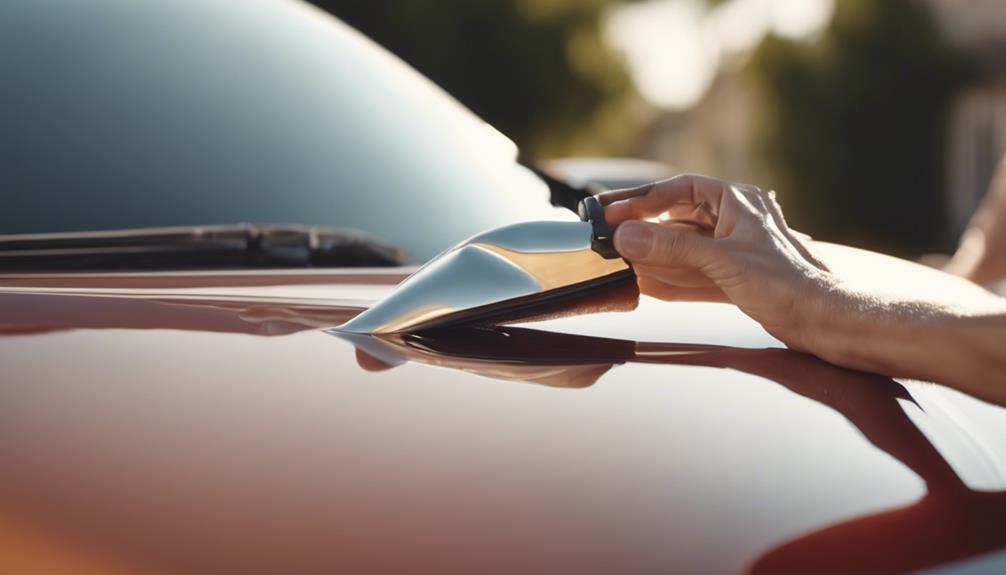
Quality Waxing
Applying a high-quality wax not only enhances your car's shine but also provides a protective barrier against environmental damage. To achieve the best results, you must focus on wax selection and proper application techniques.
Wax Selection
Choosing the right wax is vital. There are two main types: natural and synthetic. Natural waxes, like carnauba, offer a deep, rich shine. Synthetic waxes, on the other hand, provide longer-lasting protection. Consider your goals and the climate you live in when making a choice. For instance, synthetic waxes are ideal for areas with harsh weather conditions.
Application Techniques
Proper application is key to maximizing the benefits of your chosen wax. Follow these steps:
- Preparation: Make sure your car is clean and dry. Any dirt or water can interfere with the wax's ability to bond with the paint.
- Application: Use a foam or microfiber applicator pad. Apply the wax in small, circular motions, covering one section at a time.
- Buffing: Allow the wax to haze over, usually for about 5-10 minutes. Then, use a clean, dry microfiber cloth to buff the surface, revealing a brilliant shine.
Paint Sealants
Paint Sealants
While waxing offers excellent shine and protection, paint sealants take it a step further by providing more durable and long-lasting defense for your car's finish. Unlike traditional wax, synthetic sealants are formulated to withstand harsher environmental conditions. They create a stronger bond with the car's paint, resulting in a protective layer that can last up to six months or more.
Benefits of Paint Sealants
Paint sealants offer several key advantages over waxes:
- Durability: Sealants provide a longer-lasting shield, making them ideal for vehicles exposed to extreme weather or frequent washing.
- Enhanced Protection: They protect against UV rays, oxidation, and contaminants like bird droppings and sap.
- Ease of Application: Synthetic sealants are easier to apply and remove compared to some traditional waxes.
Application Process
- Prepare the Surface: Before applying a paint sealant, make sure your car's surface is clean. Use polishing compounds to remove any existing imperfections or oxidation.
- Apply the Sealant: Follow the manufacturer's instructions for the best results. Typically, you'll apply a thin layer using a foam applicator.
- Buff and Cure: Once applied, let it cure for the recommended time, then buff off any excess with a microfiber cloth.
Regular use of paint sealants will keep your car looking pristine while providing superior protection.
Detailing Clay
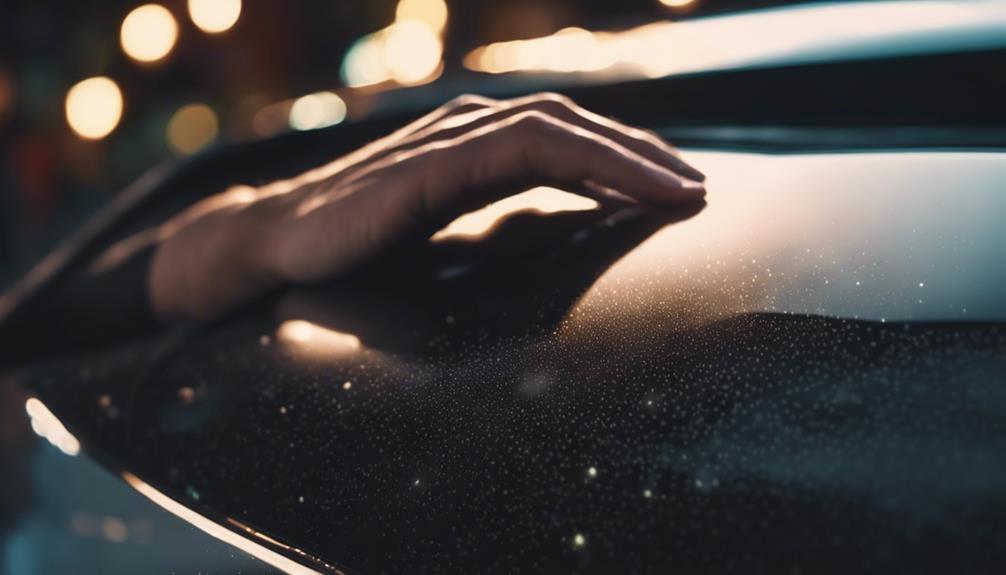
Detailing Clay
Detailing clay helps remove embedded contaminants from your car's paint, leaving the surface smooth and ready for further treatment. When you wash your car, some contaminants like tree sap, brake dust, and industrial fallout can remain. Using detailing clay guarantees these particles are effectively removed.
Steps to Use Detailing Clay
- Prepare the Surface: Start by washing and drying your car thoroughly. This removes loose dirt and grime.
- Clay Lubrication: Apply a clay lubrication spray generously on a small section of the car. This prevents the clay from sticking to the paint and causing damage.
- Contaminant Removal: Mold the clay into a flat, manageable piece. Gently glide it over the lubricated section using light pressure. You'll feel the clay picking up contaminants. When the surface feels smooth, move to the next section.
- Check the Clay: Frequently inspect the clay for embedded contaminants. Fold it to expose a clean surface as needed to avoid scratching the paint.
- Final Wipe Down: After claying the entire car, wipe down the surface with a clean, dry cloth to remove any clay residue.
Using Microfiber Cloths
Using microfiber cloths is essential for keeping your car's paint looking pristine. You'll need to master the proper cleaning technique, avoid scratches, and maintain the cloths correctly for best results. Let's break down these points to help you achieve that flawless shine.
Proper Cleaning Technique
Proper Cleaning Technique (Using Microfiber Cloths)
When cleaning your car, opting for microfiber cloths guarantees a scratch-free and effective shine. Begin by using a foam cannon to apply soap evenly across the vehicle's surface. This step helps loosen dirt and grime, making the cleaning process smoother.
Steps to Follow
- Foam Cannon Application:
- Attach the foam cannon to your pressure washer.
- Cover your car with a thick layer of foam to lift contaminants.
- Let the foam sit for a few minutes, but don't allow it to dry.
- Initial Rinse:
- Use a hose or pressure washer to rinse off the foam and loosened dirt.
- Microfiber Cloth Washing:
- Dip a clean microfiber cloth into a bucket of soapy water.
- Gently wipe the car in straight lines, avoiding circular motions.
- Rinse the cloth frequently to remove trapped dirt.
- Wheel Cleaning:
- Use a separate microfiber cloth for the wheels.
- Clean the wheels last to prevent transferring brake dust and grime to the car's paint.
- Final Rinse and Dry:
- Rinse the car thoroughly to remove all soap residues.
- Dry the car using a dry microfiber cloth to prevent water spots.
Following these steps guarantees your car maintains a brilliant shine without scratches.
Avoiding Scratches
Avoiding Scratches
Preventing scratches while cleaning your car requires careful handling and the right tools. Using microfiber cloths is essential because they are designed to lift dirt and debris without causing damage to the paint. Unlike regular towels, microfiber cloths have finer fibers that are gentle on the car's surface.
Parking Habits
Your parking habits play an important role in maintaining your car's shine. Always choose parking spots away from trees and bushes that could scratch your vehicle. Additionally, avoid parking too close to other cars to prevent accidental door dings and scratches.
Safe Storage
Proper storage of your microfiber cloths is vital to avoid transferring dirt and debris back onto your car's surface. Keep them in a clean, dry place where they won't collect dust or grime. Safe storage ensures that your cloths remain effective and safe for future use.
When you wash your car, always use a gentle, circular motion with the microfiber cloth to minimize the risk of scratches. Avoid pressing too hard, as this can force dirt into the paint. By following these practices, you can keep your car's surface looking pristine and free of scratches.
Cloth Maintenance Tips
Cloth Maintenance Tips
Using Microfiber Cloths
To guarantee your microfiber cloths stay in top condition, regularly wash them separately from other laundry items. Doing so helps prevent lint from other fabrics from sticking to the microfiber.
Washing Tips:
- Use Cold Water: Cold water helps maintain the integrity of the fibers, ensuring they stay effective for longer.
- Avoid Fabric Softener: Fabric softeners can coat the fibers, reducing their ability to clean and absorb.
- Mild Detergent: Opt for a mild, liquid detergent to avoid harsh chemicals that may damage the cloths.
Stain Removal:
- Pre-Treat Stains: If your microfiber cloths have stains, pre-treat them with a small amount of liquid detergent before washing.
- Gentle Scrub: Gently scrub the stained area with your fingers or a soft brush to help lift the stain.
Drying Tips:
- Air Dry: Air drying is the best method to preserve the microfiber's quality.
- Low Heat: If you must use a dryer, set it to low heat to prevent the fibers from melting or losing their shape.
Lint Prevention:
- Dedicated Storage: Store your microfiber cloths in a clean, dry place, away from other fabrics to avoid lint transfer.
- Regular Inspection: Regularly inspect your cloths for lint and remove any that you find manually.
Protecting From Elements
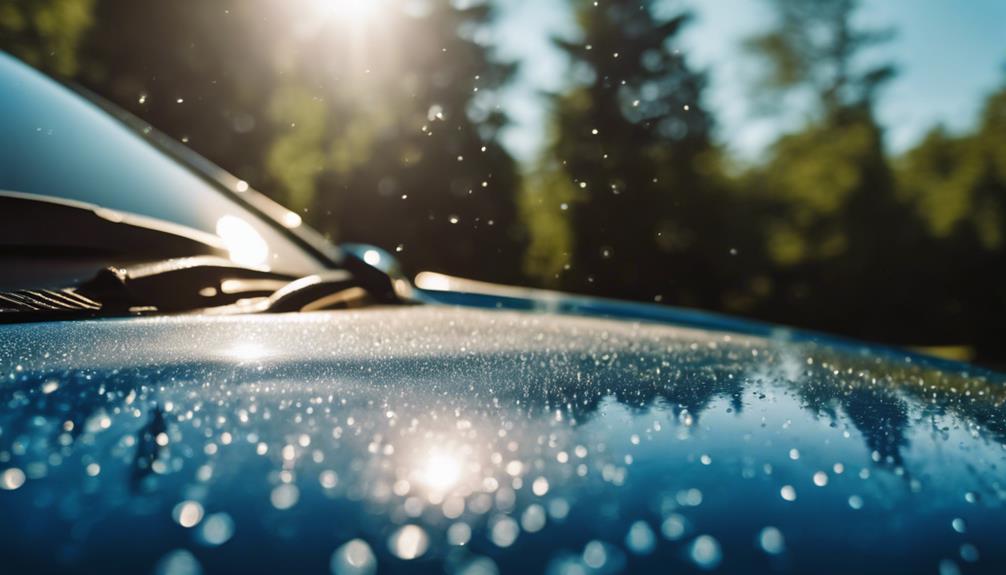
To protect your car's shine from the elements, you should focus on two main practices: regular wax application and using car covers. Applying wax creates a protective layer that shields your car's paint from harmful UV rays, dirt, and moisture. Using a car cover when your vehicle is parked outdoors adds an extra barrier against dust, rain, and sun exposure, ensuring your car retains its pristine look.
Regular Wax Application
Regular Wax Application
Applying a regular coat of wax is essential for protecting your car's paint from harsh environmental elements. Seasonal waxing guarantees that your vehicle maintains its shine and provides a protective barrier against rain, snow, and UV rays. For best results, you should wax your car at least four times a year, coinciding with the change of seasons.
Seasonal Waxing
- Spring: Remove winter grime and prepare for summer heat.
- Summer: Protect against intense sunlight and heat damage.
- Fall: Shield your car from falling leaves and debris.
- Winter: Guard against road salt and freezing temperatures.
Product Recommendations
Selecting the right wax product is important. Here are some top choices:
- Carnauba Wax: Offers a deep, glossy shine and is ideal for summer.
- Synthetic Wax: Provides long-lasting protection and is great for winter.
- Spray Wax: Easy to apply and suitable for quick touch-ups between regular waxing sessions.
When applying wax, follow these steps:
- Clean: Wash and dry your car thoroughly.
- Apply: Use a foam applicator to apply a thin, even layer of wax.
- Buff: Allow the wax to dry to a haze, then buff it off with a microfiber cloth.
Use Car Covers
Use Car Covers
Using a car cover is a simple yet effective way to protect your vehicle from environmental elements. Car covers act as a protective barrier, shielding your car from harmful UV rays, rain, snow, and dust. This helps maintain your car's shine and reduces the risk of damage to the paint.
Benefits of Using Car Covers
- UV Protection: Prolonged exposure to sunlight can fade your car's paint. A car cover blocks UV rays, preserving the color and finish.
- Weather Resistance: Rain and snow can cause rust and other damage. A quality car cover keeps your vehicle dry and safe from these elements.
- Dust and Debris: Even when parked indoors, dust can settle on your car, dulling its shine. A car cover guarantees your car stays clean and polished.
Choosing the Right Car Cover
- Material: Look for breathable fabrics that prevent moisture buildup, which can lead to mold and mildew.
- Fit: Ensure the cover fits your car snugly to provide maximum protection.
- Indoor Storage: Even in a garage, a car cover adds an extra layer of protection against dust and minor scratches.
Routine Inspections
Routine Inspections
Regularly inspecting your car is essential for maintaining its shine and ensuring it remains in top condition. One of the first things you should check is the tire pressure. Properly inflated tires not only enhance your car's performance but also contribute to its overall appearance. Low tire pressure can cause uneven wear and detract from the car's clean look. Make it a habit to check your tire pressure at least once a month.
Another critical aspect of routine inspections is verifying the fluid levels. This includes engine oil, coolant, brake fluid, and windshield washer fluid. Maintaining appropriate fluid levels guarantees your car runs smoothly and prevents any leaks or spills that could mar its exterior. Always top off fluids as needed and address any leaks immediately.
Additional Inspection Points
- Exterior: Examine the paint for chips or scratches. Address minor damages promptly to prevent rust and further deterioration.
- Windows and Mirrors: Ensure they are clean and free of cracks or chips. Replace damaged components to maintain clear visibility.
- Lights: Check that all lights are functioning correctly. Replace any burnt-out bulbs to guarantee safety and visibility.

